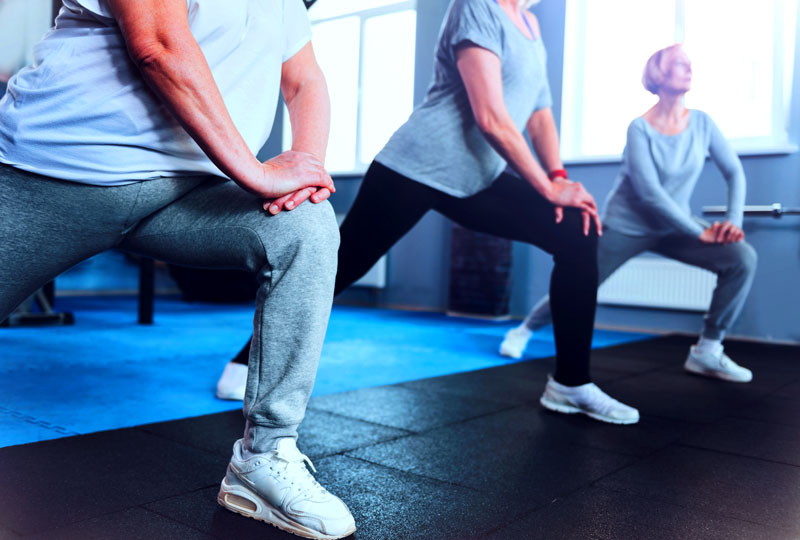These knee strengthening exercises will help you ease into a fitness routine for knee pain.
Do you have a history of chronic knee pain that limits you from starting or maintaining a fitness routine?
Certain exercises performed regularly can improve strength and flexibility and ease knee pain in the process. Here, Leon Scott, M.D., of Vanderbilt Orthopaedics Division of Sports Medicine, provides insight on staying active with pain along with some knee strengthening exercises to help.
Five principles when it comes to exercising with knee pain:
- Get help if pain acutely increases. As a rule of thumb, if pain increases suddenly without improving on its own within three days, seek advice from a medical professional. “Temporary use of pain-relieving medicines, braces and recommended gentle exercises tailored for your exact symptoms can be a bridge between the acute issue and your plan for chronic knee pain control,” Scott said.
- Make exercise a part of your daily or weekly routine. “If you start a routine of at least three days a week of strengthening,” Scott said, “that has probably the biggest impact on overall knee pain and knee health, but also just for your overall well-being.”
- Strengthen base structures, such as the core and the hips. When you use muscles to move a joint, such as the knee, you tighten the muscles in your core first. That’s the headquarters, Scott explained. And when you strengthen that core, your other muscles have a more secure structure to use as support. “Strengthening those areas just allows the whole leg, in theory, to move a lot more efficiently,” he added, “so there’s less pain because there’s more stability.”
- Challenge your balance. Between age 30 and 65, our bodies start to shut down muscles that aren’t being used, Scott said. “The saying ‘If you don’t use it, you lose it’ applies here,” he added. His observation is that if the systems that control balance start to fade because they aren’t being challenged, knee pain can often arise. “You have to challenge balance to actually improve it,” he explained. “Start with a modest challenge and write out a plan to increase the difficulty. For example, increase the length of time you do a balance exercise by a count of 10 each week or change your stance.” Standing on one foot, like in the balance drill provided below, is a good example of a challenge. If that’s too hard, start with your feet together or place your feet in tandem.
- Keep your feet on a surface. “If you sit in one of the leg extension machines,” Scott explained, “that will not be as effective as doing a leg press or squatting, even though many of the same muscles are being utilized. Having your feet on a surface will likely translate into more useful strength and pain control when you’re actually getting up from a chair or getting out of your car.”
Dr. Scott recommends trying the following four knee strengthening exercises, using the provided videos as a guide:
Reverse crunches: Avoid arching your back. The goal is to complete 10 repetitions with straight legs. Start with bent knees. Repeat daily.
Balance drills: Aim for 30 seconds on each foot while not wearing shoes. Use your other foot for balance if necessary. Avoid wiggling or flailing your arms. Repeat daily.
PVC squats: The video demonstrates a hip hinge exercise with the help of a dowel to show the correct alignment of the head, back and buttocks. You can use a broomstick at home to learn the correct positioning, then perform the hinge without the stick or pole. Aim for 10 repetitions. Repeat three to five days per week.
Side-to-side band walks: This video demonstrates the exercise with the use of an X-band to add resistance. Alternatively, you can use a smaller resistance band looped around your legs like a belt at knee height. You can find exercise bands in the fitness aisles of many stores. Start with light resistance. With your head, back and buttocks in alignment and your chin tucked, sit back in a half squat. Push your knees out and prevent them from buckling inward. Start in front of a mirror, if possible. Aim for 10 steps to the right and 10 steps to the left. Repeat three to five days per week.

If you are dealing with an injury, facing surgery or coping with chronic pain, Vanderbilt Orthopaedics offers a full spectrum of care. Our specialists work with you from evaluation and “prehab” through physical therapy and, if needed, surgery. We’ll help you get back to doing the things you love, pain-free. To make an appointment, call 615-936-7846.

